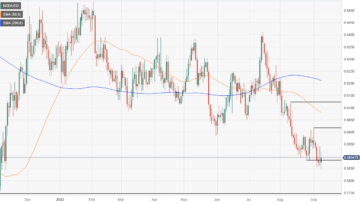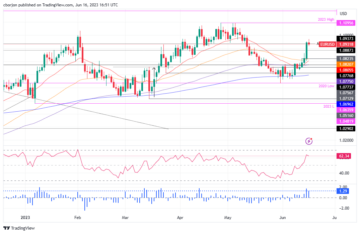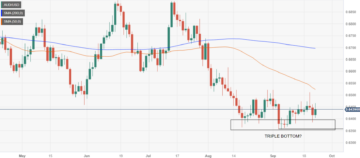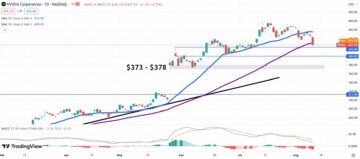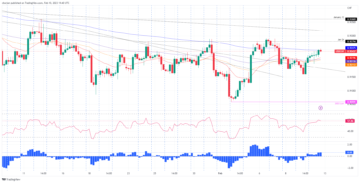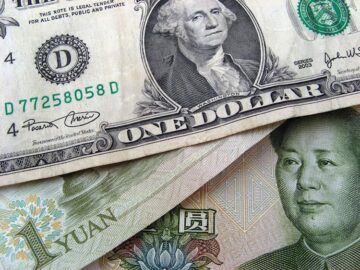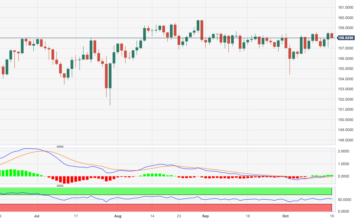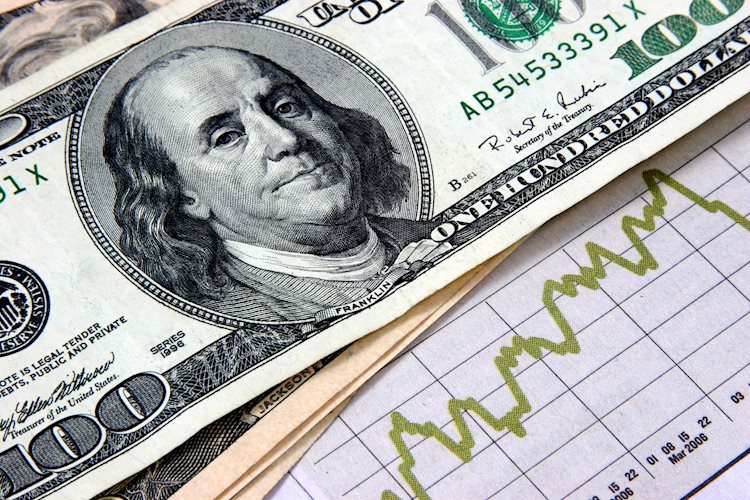
- The US Dollar extends losses to levels not seen since mid-January.
- US Jobs report confirms uptick in unemployment and employers not willing to pay more for labor force.
- The US Dollar Index trades below 103.00, and on its way to testing lower end of 102.
The US Dollar (USD) is locking in its sixth consecutive day of losses with another leg lower. This time the catalyst behind the move comes from the US Jobs Report where, although the Nonfarm Payrolls number was an upbeat surprise, the chunky downward revision of the previous number tripped the US Dollar. Traders went all in once they saw that the Unemployment rate and the Average Hourly Earnings were pointing as well to contraction.
On the economic calendar front, all is done for this week. Markets can now let the data settle, though it has been a pivotal week where the US Challenger Job Cuts, the weekly Jobless Claims and now this Jobs Report confirm that the tide is turning for the US. This opens a window of opportunity for the US Federal Reserve to pull the trigger of rate cuts at one of its next meetings after March.
Daily digest market movers: Job Market starting to roll over
- The US Jobs Report for February delivered some surprises:
- Nonfarm Payrolls growth came in at 275,000, above expectations. Though traders ignored the number and rather saw the downward revision from the previous 353,000 to 229,000 as a negative surprise.
- Growth in Yearly Average Hourly Earnings fell slightly as expected from 4.4% to 4.3%.
- Monthly Average Hourly Earnings shrunk from 0.6% to only 0.1%.
- The Unemployment Rate was the last big surprise with an uptick from 3.7% to 3.9%.
- Equities are flat to mildly in the green after the Asia closing. Equities were on fire on Thursday after Powell commented that the Fed is ready to cut once data falls in line.
- According to the CME Group’s FedWatch Tool, expectations for a Fed pause in the March 20 meeting are at 95%, while chances of a rate cut stand at 5%.
- The benchmark 10-year US Treasury Note trades around 4.09%, the lowest level in over a week.
US Dollar Index Technical Analysis: DXY holds above 102
The US Dollar Index (DXY) is making its way to the lower end of 102 and is bleeding severly after the Greenback got injured again after the recent release of the US Jobs Report. The biggest element to take away is that Unemployment is starting to rise, together with employers unwilling to pay substantially more to keep or hire personel. This could be the first signal that the job market is turning and more downbeat and negative data is set to come out in the coming weeks.
On the upside, the first reclaiming ground is at 103.28, the 55-day Simple Moving Average (SMA), and at the 200-day SMA near 103.72. Once broken through, the 100-day SMA is popping up at 103.81, so a bit of a double cap in that region. Depending on the catalyst that pushes the DXY upwards, 104.60 remains the key level on the topside.
The DXY is trading a bit in nomad’s land, with not really any significant support levels nearby. More downside looks inevitable with 101.75 up next, which bears some pivotal relevance. Once through there, the road is open for another leg lower to 100.61, the low of 2023.
US Dollar FAQs
The US Dollar (USD) is the official currency of the United States of America, and the ‘de facto’ currency of a significant number of other countries where it is found in circulation alongside local notes. It is the most heavily traded currency in the world, accounting for over 88% of all global foreign exchange turnover, or an average of $6.6 trillion in transactions per day, according to data from 2022. Following the second world war, the USD took over from the British Pound as the world’s reserve currency. For most of its history, the US Dollar was backed by Gold, until the Bretton Woods Agreement in 1971 when the Gold Standard went away.
The most important single factor impacting on the value of the US Dollar is monetary policy, which is shaped by the Federal Reserve (Fed). The Fed has two mandates: to achieve price stability (control inflation) and foster full employment. Its primary tool to achieve these two goals is by adjusting interest rates. When prices are rising too quickly and inflation is above the Fed’s 2% target, the Fed will raise rates, which helps the USD value. When inflation falls below 2% or the Unemployment Rate is too high, the Fed may lower interest rates, which weighs on the Greenback.
In extreme situations, the Federal Reserve can also print more Dollars and enact quantitative easing (QE). QE is the process by which the Fed substantially increases the flow of credit in a stuck financial system. It is a non-standard policy measure used when credit has dried up because banks will not lend to each other (out of the fear of counterparty default). It is a last resort when simply lowering interest rates is unlikely to achieve the necessary result. It was the Fed’s weapon of choice to combat the credit crunch that occurred during the Great Financial Crisis in 2008. It involves the Fed printing more Dollars and using them to buy US government bonds predominantly from financial institutions. QE usually leads to a weaker US Dollar.
Quantitative tightening (QT) is the reverse process whereby the Federal Reserve stops buying bonds from financial institutions and does not reinvest the principal from the bonds it holds maturing in new purchases. It is usually positive for the US Dollar.
- SEO Powered Content & PR Distribution. Get Amplified Today.
- PlatoData.Network Vertical Generative Ai. Empower Yourself. Access Here.
- PlatoAiStream. Web3 Intelligence. Knowledge Amplified. Access Here.
- PlatoESG. Carbon, CleanTech, Energy, Environment, Solar, Waste Management. Access Here.
- PlatoHealth. Biotech and Clinical Trials Intelligence. Access Here.
- Source: https://www.fxstreet.com/news/us-dollar-weakens-sharply-on-dovish-fed-expectations-ahead-of-nfp-202403081245
- :has
- :is
- :not
- :where
- $UP
- 00
- 000
- 10
- 100
- 101
- 102
- 11
- 2%
- 20
- 2008
- 2022
- 2023
- 28
- 4
- 6
- 60
- 72
- 75
- 95%
- a
- above
- According
- Accounting
- Achieve
- adjusting
- After
- again
- Agreement
- All
- alongside
- also
- Although
- america
- an
- analysis
- and
- Another
- any
- ARE
- around
- AS
- asia
- At
- average
- away
- backed
- Banks
- BE
- Bears
- because
- been
- behind
- below
- Benchmark
- Big
- Biggest
- bis
- Bit
- Bleeding
- Bonds
- Bretton
- Bretton Woods
- British
- British Pound
- Broken
- buy
- Buying
- by
- came
- CAN
- cap
- carpet
- Catalyst
- challenger
- chances
- choice
- chunky
- Circulation
- claims
- closing
- CME
- combat
- come
- comes
- coming
- coming weeks
- commented
- Confirm
- consecutive
- contraction
- control
- control inflation
- could
- Counterparty
- countries
- credit
- crisis
- crunch
- Currency
- Cut
- cuts
- data
- day
- Default
- delivered
- Depending
- Digest
- does
- Dollar
- dollar index
- dollars
- done
- double
- downside
- downward
- during
- Dxy
- each
- Earnings
- easing
- Economic
- element
- employers
- employment
- end
- Equities
- exchange
- expectations
- expected
- extends
- extreme
- factor
- Falls
- FAQ
- fear
- February
- Fed
- Federal
- federal reserve
- financial
- financial crisis
- Financial institutions
- financial system
- Fire
- First
- flat
- flow
- following
- For
- Force
- foreign
- foreign exchange
- forex
- Foster
- found
- from
- front
- full
- Global
- Goals
- Gold
- Gold Standard
- got
- Government
- government bonds
- great
- Green
- Greenback
- Ground
- Group’s
- Growth
- heavily
- helps
- High
- hire
- history
- holds
- HTTPS
- impacting
- important
- in
- Increases
- index
- inevitable
- inflation
- initial
- institutions
- interest
- Interest Rates
- involves
- IT
- ITS
- Job
- job cuts
- jobless claims
- Jobs
- jobs report
- jpg
- june
- Keep
- Key
- labor
- Land
- Last
- Leads
- LEND
- let
- Level
- levels
- Line
- local
- locking
- LOOKS
- losses
- Low
- lower
- lowering
- lowest
- lowest level
- Making
- mandates
- March
- Market
- Markets
- May..
- measure
- meeting
- meetings
- Monetary
- Monetary Policy
- more
- most
- move
- Movers
- moving
- moving average
- Near
- necessary
- negative
- New
- next
- NOMAD
- note
- Notes
- now
- number
- numbers
- occurred
- of
- official
- on
- once
- ONE
- only
- open
- opens
- Opportunity
- or
- Other
- out
- over
- pause
- Pay
- Payrolls
- per
- pivotal
- plato
- Plato Data Intelligence
- PlatoData
- policy
- popping
- positive
- pound
- Powell
- predominantly
- previous
- price
- Prices
- primary
- Principal
- printing
- process
- purchases
- pushes
- QE
- QT
- quantitative
- Quantitative Easing
- quickly
- raise
- Rate
- Rates
- rather
- ready
- really
- recent
- Red
- region
- reinvest
- release
- relevance
- remains
- report
- Reserve
- Reserve Currency
- Resort
- result
- reverse
- Rise
- rising
- road
- Roll
- Rolling
- s
- saw
- Second
- Second world war
- seen
- sees
- set
- settle
- shaped
- Signal
- significant
- Simple
- simply
- since
- single
- situations
- sixth
- slightly
- SMA
- So
- some
- Stability
- stand
- standard
- Starting
- States
- Stops
- stuck
- substantially
- support
- support levels
- surprise
- surprises
- system
- Take
- Target
- Technical
- Technical Analysis
- Testing
- that
- The
- the Fed
- The United States of America
- The US Federal Reserve
- The Weekly
- the world
- Them
- There.
- These
- they
- this
- this week
- though?
- Through
- thursday
- Tide
- tightening
- time
- to
- together
- too
- took
- tool
- traded
- Traders
- trades
- Trading
- Transactions
- treasury
- trigger
- Trillion
- Turning
- turnover
- two
- unemployment
- unemployment rate
- United
- United States
- UNITED STATES OF AMERICA
- unlikely
- until
- upbeat
- Upside
- upwards
- us
- US Dollar
- US Dollar Index
- US Federal
- us federal reserve
- us government
- US Jobs Report
- US Treasury
- USD
- USD value
- used
- using
- usually
- v1
- value
- war
- was
- Way..
- weaker
- week
- weekly
- Weeks
- weighs
- WELL
- went
- were
- when
- which
- while
- will
- willing
- window
- with
- Woods
- world
- world’s
- yearly
- zephyrnet

